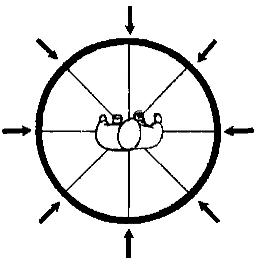
|
Avenues Of Approach |
|
by Grand Master James S. Benko, Ph.D. |
|
There are many different directions from which an
opponent may enter your defensive sphere. But there are
eight directions from which he may attack that would not only
permit him to enter but to off-balance you as well. These
eight directions are referred to as the eight AVENUES OF
APPROACH.
Understanding the avenues of approach is of vital
importance for three primary reasons. First, because the
avenues of approach are your weakest points of defense, you
must protect these "avenues" against infiltration by an
opponent. Since the "avenues' are also the weakest areas of
the opponent, you will want to direct your techniques toward
these areas in order to penetrate his defense and subdue him.
Finally, an in-depth knowledge of the avenues of approach
will better enable you to grasp the concept of a "multi-directional
defense", which deals with defending against
several opponents attacking from different directions. Let's
take a look at each reason.
|

|
|
|
In a confrontation it is the objective of the opponent to penetrate your defensive position and render you unable to further defend yourself. To protect against penetration of your defenses you must guard your avenues of approach. There are several ways to accomplish this. As the opponent closes in along one of the avenues, move yourself into a new defensive position which denies the opponent access to his original line of attack. He will be forced to alter his approach, which gives you additional time to probe for weaknesses in his defense or seek an means to disengage from actual physical confrontation. Strategic positioning goes hand-in-hand with using the avenues of approach to enter the opponent's defenses and applying a technique of neutralization. You position yourself so you will be able to use one of the opponent's avenues to engage him. You will then be able to off-balance an opponent and place him in a position in which he must commit himself to defending the avenue under attack. This means he will be limited to defense making it almost impossible for him to initiate an attack against you. Finally, as you develop your ability to recognize and employ the avenues of approach to your advantage, you will progress to the level of multi-directional defense. You will be able to close your avenues of approach to opponents while using their avenues to penetrate their defenses and apply your techniques of neutralization. The multi-directional defense is the foundation for defending against several opponents simultaneously. The eight avenues of approach are the angles which are your weakest points. That is, if an opponent were to move toward you and push you in the direction of one of these "avenues", you would be knocked off balance quite easily. Since the eight avenues of approach are our weakest areas of defense, they should be carefully guarded. This may be accomplished by body-shifting or moving along one of the ANGLES OF EVASION. In order to make effective use of the avenues of approach in a defensive situation you must also realize you will move along these "avenues" to evade attacks. At this point the AVENUES OF APPROACH become your ANGLES OF EVASION. |
"Theories of Defensive Action" and the "Avenues Of Approach".
 |
All rights reserved.